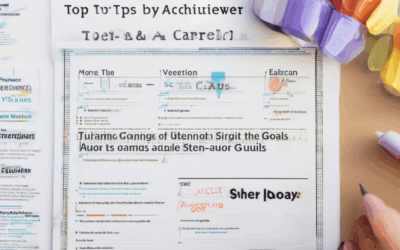Staying focused in today’s fast-paced world can feel like an uphill battle, especially when distractions seem endless. Whether you’re juggling work, family, or personal projects, maintaining concentration often feels elusive. This is where mindfulness comes into play—a practice that not only helps quiet the mind but also sharpens your ability to stay present and productive. In this article, we’ll explore the essential strategies and techniques rooted in mindfulness that can help you achieve better focus, regardless of whether you’re tackling everyday tasks or pursuing personal growth. By understanding the core principles of mindfulness, you’ll learn how to manage stress, improve decision-making, and cultivate a mindset that thrives on clarity and purpose. Let’s dive into the transformative power of mindfulness and discover how it can revolutionize your approach to focus and productivity.
Key Takeaways
– Reflect: Set clear intentions to guide your mindfulness practice and improve focus.
– Release: Use body scan meditation and breathing exercises to calm your mind and reduce restlessness.
– Rebalance: Incorporate gentle movement, yoga, or walking meditation to enhance focus and reduce physical tension.
– Reset: Practice gratitude daily to shift your mindset and improve emotional well-being.
– Relabel: Engage with support groups or seek guidance from coaches or therapists to gain valuable strategies and reduce isolation.

What are the 5 R’s of mindfulness?
- Recognize: Begin by noticing the present moment. Pay attention to your senses, thoughts, and feelings without judgment.
- Relabel: Assign words or phrases to your experiences. For example, label emotions like “anxious” or sensations like “calm.”
- Respond: Take intentional actions based on your observations. This might include breathing exercises, stretching, or simply pausing to acknowledge your feelings.
- Rebalance: Return your focus to the present moment after becoming distracted. Use techniques like grounding exercises to reconnect with your surroundings.
- Return: After completing your mindfulness practice, bring your awareness back to the present reality, carrying the calmness with you into daily life.
What Are the 3 C’s of Mindfulness?
Mindfulness is often broken down into three key components, known collectively as the “Three Cs.” These principles guide individuals in developing a deeper understanding and practice of mindfulness. Here’s a breakdown of each:
- Attention :
- Definition : Focuses on cultivating present-moment awareness.
- Importance : It involves noticing sensations, emotions, and thoughts without judgment. This helps in staying grounded and engaged in the current experience.
- Acceptance :
- Definition : Involves embracing experiences with curiosity and openness.
- Importance : It encourages individuals to accept their thoughts and feelings as they are, fostering a non-judgmental mindset.
- Intention :
- Definition : Relates to setting a purpose or direction for one’s mindfulness practice.
- Importance : It helps in aligning the practice with personal goals, such as reducing stress or enhancing well-being.
By integrating these three elements, mindfulness becomes a holistic practice that promotes mental, emotional, and physical well-being.

What are the 4 P’s of mindfulness?
The 4P’s of mindfulness are a powerful framework for cultivating awareness and intentionality in daily life. These principles help individuals navigate challenges, enhance relationships, and find meaning in moments.
- Presence
- Presence is the foundation of mindfulness, requiring full engagement in the current moment. It involves acknowledging your surroundings, emotions, and thoughts without judgment.
- Practicing presence allows you to connect deeply with others, fostering empathy and understanding in interactions.
- Techniques include meditation, breathing exercises, and mindful listening to stay grounded in the present.
-
Pacing
- Pacing emphasizes balancing activity with rest, recognizing the importance of rhythm in life. It encourages you to move mindfully through tasks, avoiding overwhelm.
- By pacing yourself, you can manage stress and maintain energy levels, ensuring sustained focus and productivity.
-
Prioritizing
- Prioritizing involves clarifying intentions and focusing on what truly matters. It’s about aligning actions with your values and goals, reducing distractions.
- Mindful prioritization helps you make decisions that resonate with your long-term vision, leading to greater fulfillment and efficiency.
-
Pivoting
- Pivoting is the ability to adapt gracefully to changes and challenges. It involves flexibility in thought and action, allowing you to shift perspectives when circumstances evolve.
- Cultivating mindfulness enhances resilience, enabling you to remain calm and resourceful even when plans change.
By integrating these 4P’s into your daily routine, you can develop a more balanced and purposeful approach to life, thriving amidst uncertainty and embracing opportunities for growth.

How to Practice Mindfulness for ADHD
Mindfulness practices can significantly benefit individuals with ADHD by helping to manage attention, reduce stress, and improve overall well-being. Below are some effective strategies to incorporate mindfulness into daily life:
- Set Clear Intentions : Begin your mindfulness practice by defining your intention. Whether it’s to calm your mind before work or to improve focus during tasks, having a clear purpose can guide your efforts.
- Schedule Regular Sessions : Establish a consistent routine. Even short sessions, such as 5 minutes twice a day, can make a difference. Consistency helps build the habit of mindfulness.
- Practice Body Scan Meditation : Find a quiet space and sit comfortably. Close your eyes and bring your attention to your breath. Notice any sensations in your body and observe them without judgment. This practice can help ground you in the present moment and reduce restlessness.
- Breathing Exercises : Focus on deep, controlled breathing. Inhale for four counts and exhale for six counts. This rhythm can help calm the mind and reduce anxiety associated with ADHD.
- Engage in Gentle Movement : Incorporate movement into your mindfulness practice. Try light stretching, yoga, or walking meditation to help release tension and improve focus.
- Use Visualization Techniques : Visualize a calm, peaceful place in your mind. Imagine yourself there and take a few moments to explore the details. This can help create a mental escape from overwhelming emotions or thoughts.
- Practice Gratitude : Take a few moments each day to reflect on things you’re grateful for. This can shift your mindset from negativity to positivity, which is particularly beneficial for managing ADHD symptoms.
- Seek Support Groups : Connecting with others who have ADHD can provide valuable support and shared strategies. Engaging with communities can also help reduce feelings of isolation.
Mindfulness is a skill that improves with practice. Be patient with yourself and understand that it may take time to develop. With consistent effort, mindfulness can become a powerful tool in managing ADHD and enhancing your overall quality of life.
Learn more about mindfulness practices and other tools for managing ADHD on 7Del.net .
How to Train an ADHD Brain to Focus
Training an ADHD brain to focus requires a combination of strategies, patience, and understanding. Here are some effective methods to help improve focus:
- Break Tasks into Smaller Steps: Divide large tasks into manageable, smaller tasks. Use a timer to set specific intervals and celebrate completing each step.
- Practice Mindfulness:** Engage in mindfulness or meditation exercises for a few minutes daily. Techniques like focusing on breath or observing thoughts without judgment can enhance concentration.
- Stay Grounded:** Use sensory cues, such as touching an object or focusing on a specific sight, to anchor your attention in the present moment.
- Establish Routines:** Create a predictable daily schedule with designated times for work, play, and relaxation. Visual reminders like sticky notes can help stay on track.
- Seek Support:** Work with a coach or therapist specializing in ADHD to get personalized strategies. Join support groups for shared experiences and encouragement.
- Include Physical Activity:** Incorporate regular exercise or movement breaks to release endorphins that boost focus.
- Evaluate Nutrition:** Consume foods rich in omega-3s and limit caffeine and sugar intake to support cognitive health and prevent energy crashes.
- Minimize Distractions:** Use apps to block distracting websites and create dedicated work zones free from clutter. Avoid multitasking to maintain focus.
- Use Positive Reinforcement:** Celebrate small achievements with rewards and consider gamifying tasks to increase engagement.
- Maintain Hydration and Sleep:** Ensure adequate hydration and consistent sleep schedules to support optimal brain function.
- Practice Self-Compassion:** Accept ADHD as part of your identity without shame. Cultivate self-compassion to reduce stress and foster a positive mindset toward learning and applying strategies.

Is It Harder for People with ADHD to Meditate?
Yes, individuals with ADHD often find meditation challenging due to difficulties in maintaining focus, managing impulsivity, and managing restlessness.
Challenges Faced by Individuals with ADHD During Meditation
- Difficulty Focusing: Maintaining concentration is often hard due to a tendency toward distractibility and a fast-paced mindset.
- Impulsivity: The mind often races, making it difficult to stay present and engaged during meditation sessions.
- Restlessness: Physical activity or an inability to sit still can interfere with traditional meditation practices.
Strategies to Overcome Challenges
- Structured Routine: Establishing a consistent meditation schedule can help build habits despite distractions.
- Adaptability: Experiment with different meditation styles, such as walking meditation or mindfulness of breath, to find what works best.
- Movement Integration: Incorporate brief movements or physical activities into your practice to alleviate restlessness.
- Gratitude Practice: Focusing on moments of gratitude can ground individuals and reduce feelings of impatience.
- Seeking Support: Exploring guided meditation apps or joining groups can provide structure and accountability.
Conclusion
Meditation can be more challenging for individuals with ADHD, but with the right strategies and persistence, it remains a valuable tool for managing symptoms and improving overall well-being.




0 Comments